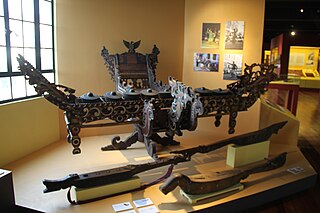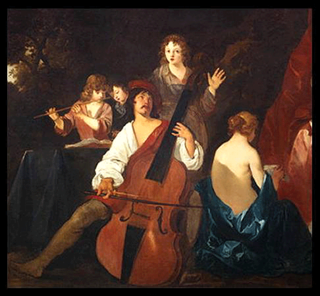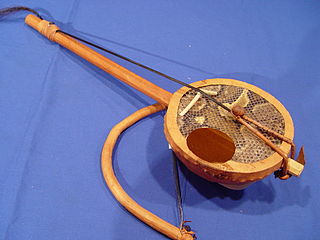
The oud is a short-neck lute-type, pear-shaped, fretless stringed instrument, usually with 11 strings grouped in six courses, but some models have 5 or 7 courses, with 10 or 13 strings respectively.

Kulintang is a modern term for an ancient instrumental form of music composed on a row of small, horizontally laid gongs that function melodically, accompanied by larger, suspended gongs and drums. As part of the larger gong-chime culture of Southeast Asia, kulintang music ensembles have been playing for many centuries in regions of the Eastern Indonesia, Southern Philippines, Eastern Malaysia, Brunei and Timor, Kulintang evolved from a simple native signaling tradition, and developed into its present form with the incorporation of knobbed gongs from Sundanese people in Java Island, Indonesia. Its importance stems from its association with the indigenous cultures that inhabited these islands prior to the influences of Hinduism, Buddhism, Islam, Christianity or the West, making Kulintang the most developed tradition of Southeast Asian archaic gong-chime ensembles.

The Tboli people are one of the indigenous peoples of South Cotabato in southern Mindanao. In the body of ethnographic and linguistic literature on Mindanao, their name is variously spelt Tboli, T'boli, Tböli, Tagabili, Tagabilil, Tagabulul and Tau Bilil. Their endonym is Tboli. Their whereabouts and identity are somewhat imprecise in the literature; some publications present the Tboli and the Tagabili as distinct peoples; some locate the Tbolis in the vicinity of Lake Buluan in the Cotabato Basin or in Agusan del Norte. The Tbolis, then, reside on the mountain slopes on either side of the upper Alah Valley and the coastal area of Maitum, Maasim and Kiamba. In former times, the Tbolis also inhabited the upper floor of the Alah Valley. After World War II and the arrival of settlers from other parts of the Philippines, they have been gradually pushed to the mountain slopes. As of now, they have almost been expelled from the fertile valley floor.

The Maranao people, also spelled Meranao, Maranaw, and Mëranaw, is the term used by the Philippine government to refer to the southern indigenous people who are the "people of the lake", a predominantly-Muslim Lanao province region of the Philippine island of Mindanao. They are known for their artwork, weaving, wood, plastic and metal crafts and epic literature, the Darangen. They are ethnically and culturally closely related to the Iranun, and Maguindanao, all three groups being denoted as speaking Danao languages and giving name to the island of Mindanao.

Koronadal, officially the City of Koronadal, and also known as Marbel, is a 3rd class component city and capital of the province of South Cotabato, Cotabato, Philippines. According to the 2020 census, it has a population of 195,398 people.

Lake Sebu is a natural lake located in the municipality of Lake Sebu, South Cotabato within the Alah Valley region. The Philippine government has recognized it as one of the country's most important watersheds. Lake Sebu is one of the many bodies of water supplying important irrigation to the provinces of Sultan Kudarat and South Cotabato.

The term violone can refer to several distinct large, bowed musical instruments which belong to either the viol or violin family. The violone is sometimes a fretted instrument, and may have six, five, four, or even only three strings. The violone is also not always a contrabass instrument. In modern parlance, one usually tries to clarify the 'type' of violone by adding a qualifier based on the tuning or on geography, or by using other terms that have a more precise connotation. The term violone may be used correctly to describe many different instruments, yet distinguishing among these types can be difficult, especially for those not familiar with the historical instruments of the viol and violin families and their respective variations in tuning.

The Lumad are a group of Austronesian indigenous people in the southern Philippines. It is a Cebuano term meaning "native" or "indigenous". The term is short for Katawhang Lumad, the autonym officially adopted by the delegates of the Lumad Mindanao Peoples Federation (LMPF) founding assembly on 26 June 1986 at the Guadalupe Formation Center, Balindog, Kidapawan, Cotabato, Philippines. Usage of the term was accepted in Philippine jurisprudence when President Corazon Aquino signed into law Republic Act 6734, where the word was used in Art. XIII sec. 8(2) to distinguish Lumad ethnic communities from the Bangsamoro.

The goje is one of the many names for a variety of one or two-stringed fiddles from West Africa, almost exclusively played by ethnic groups inhabiting the Sahel and Sudan sparsely vegetated grassland belts leading to the Sahara. Snakeskin or lizard skin covers a gourd bowl, and a horsehair string is suspended on bridge. The goje is played with a bowstring.

Nanguan is a style of Chinese classical music from the southern Chinese province of Fujian. It is also popular in Taiwan, particularly Lukang on west coast, as well as among Overseas Chinese in Southeast Asia.

The bedug is one of the drums used in the gamelan. It is also used among Muslims in Indonesia and Malaysia to signal mosque prayer times. The hitting of the instrument is particularly done according to a rhythm that goes in an increasingly rapid pace.
The kutiyapi, or kudyapi, is a Philippine two-stringed, fretted boat-lute. It is four to six feet long with nine frets made of hardened beeswax. The instrument is carved out of solid soft wood such as that from the jackfruit tree.

The çifteli is a plucked string instrument, with only two strings, played mainly by the Gheg people of northern and central Albania, Southern Montenegro, parts of North Macedonia and Kosovo.

The Blaan people, alternatively spelled as "B'laan," are one of the indigenous peoples of Southern Mindanao in the Philippines. Their name could have derived from "bla" meaning "opponent" and the suffix "an" meaning "people." Other terms used to refer to this group are Blaan, Bira-an, Baraan, Vilanes, and Bilanes. According to a 2021 genetic study, the Blaan people also have Papuan admixture.

The South Mindanao or Bilic languages are a group of related languages spoken by the Bagobo, B'laan, T'boli, and Tiruray peoples of the southern coast of Mindanao Island in the Philippines. They are not part of the Mindanao language family that covers much of the island. The languages are:

A musical instrument is a device created or adapted to make musical sounds. In principle, any object that produces sound can be considered a musical instrument—it is through purpose that the object becomes a musical instrument. A person who plays a musical instrument is known as an instrumentalist. The history of musical instruments dates to the beginnings of human culture. Early musical instruments may have been used for rituals, such as a horn to signal success on the hunt, or a drum in a religious ceremony. Cultures eventually developed composition and performance of melodies for entertainment. Musical instruments evolved in step with changing applications and technologies.
Blaan, also known as Bilaan, is an Austronesian language of the southern Philippines, similar to Tboli.
Nepenthes tboli is a tropical pitcher plant native to the Philippines. The type specimen was collected in 1993 around Lake Parker, T'Boli, South Cotabato, Mindanao, at 1463 m above sea level.
The Muslim Independence Movement (MIM) was a secessionist political organization in the Philippines.

The tube zither is a stringed musical instrument in which a tube functions both as an instrument's neck and its soundbox. As the neck, it holds strings taut and allows them to vibrate. As a soundbox or it modifies the sound and transfers it to the open air. The instruments are among the oldest of chordophones, being "a very early stage" in the development of chordophones, and predate some of the oldest chordophones, such as the Chinese Se, zithers built on a tube split in half. Most tube zithers are made of bamboo, played today in Madagascar, India, Southeast Asia and Taiwan. Tube zithers made from other materials have been found in Europe and the United States, made from materials such as cornstalks and cactus.
















